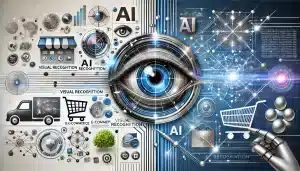AI is transforming different industries, and one of the most impacted areas is visual recognition. The ability to analyze and interpret visual data has changed product discovery and advertising strategies. This article explores how AI image recognition works, its applications in e-commerce, the challenges faced, and the future of this technology in visual recognition.
What is AI Image Recognition and How Does It Work?
Understanding AI Vision and Its Applications
AI image recognition refers to the ability of AI systems to identify and classify objects in images or videos using advanced algorithms and machine learning models. Deep learning algorithms have taken AI vision to new heights, allowing systems to analyze visual data for various applications, such as product recommendations, targeted advertising, and enhancing user experiences. With the ability to understand the intricacies of visual content, AI image recognition technology enables businesses to better connect with consumers.
The Role of Algorithms in Image Processing
Algorithms are at the heart of AI systems, playing a crucial role in image processing. These algorithms break down images into smaller components, enabling classification and object detection. The success of AI image recognition lies in the sophistication of these algorithms, which learn from vast datasets and improve over time using machine learning techniques.
How AI Image Recognition Works in Practice
In practice, AI image recognition follows several key steps: preprocessing images, extracting features, and making predictions. The AI model is initially trained with a dataset of labeled images. This allows the system to recognize patterns and classify objects accurately. Once trained, the model can analyze new images and make precise predictions. The continuous training process refines the model, reducing errors and enhancing recognition accuracy.
How Does Computer Vision Enhance Visual Recognition?
Key Computer Vision Applications in E-Commerce
Computer vision, closely related to AI image recognition, enhances visual recognition by enabling machines to understand and interpret the visual world. In e-commerce, this technology is revolutionizing product discovery. For instance, consumers can take photos of products they are interested in, and AI systems can analyze the images to suggest similar items available online. This not only simplifies shopping but also boosts conversion rates by quickly connecting consumers with relevant products.
Integrating AI Systems with Traditional Computer Vision
Combining AI with traditional computer vision techniques has greatly improved the capabilities of visual recognition. Traditional methods used predefined rules for analyzing images, while AI systems use machine learning models that evolve and improve based on new data. This integration allows for more flexible, accurate, and adaptive recognition, helping businesses refine marketing strategies and create personalized, targeted ads.
Benefits of Visual AI in Product Discovery
The use of visual AI in product discovery offers several benefits. AI image recognition helps businesses provide personalized recommendations based on customer preferences and behavior, fostering a more customer-centric approach. Additionally, visual AI can automate inventory management by analyzing stock images, ensuring that shelves are stocked with relevant products. This efficiency enables retailers to make data-driven decisions and optimize marketing efforts.
AI Image Recognition Use Cases in Advertising
AI image recognition is transforming advertising by enabling brands to deliver targeted content to specific consumer demographics. By analyzing visual data from social media and user-generated content, AI systems can identify which images resonate most with different audiences. This allows advertisers to create more effective campaigns that align with consumer preferences, driving better engagement and higher conversion rates.

Transformative Applications in Retail and Inventory Management
AI image recognition is also revolutionizing retail by enhancing inventory management and operational efficiency. Retailers can use image recognition to automatically monitor stock levels, ensuring that products are always available and minimizing the risk of stockouts. Furthermore, AI systems can analyze sales trends and customer interactions to optimize product placement and boost sales.
Facial Recognition and Surveillance Use Cases
Facial recognition is a high-end application of AI in image recognition, with significant implications for security and surveillance. By using deep learning models, facial recognition systems can accurately identify individuals in images or videos. This technology is commonly used in law enforcement, access control, and event security. However, its implementation raises ethical concerns, particularly regarding privacy, which must be carefully balanced with its benefits.
Challenges in AI Image Recognition
The Importance of Training Data for AI Models
The effectiveness of AI systems in image recognition is highly dependent on the quality and diversity of the training data. Inaccurate predictions and classifications can arise from biased or incomplete datasets. To develop robust AI models, developers must curate comprehensive datasets that represent real-world conditions, ensuring reliable image recognition results.
Common Issues in Image Analysis and Object Detection
Despite advancements, AI image recognition still faces challenges in image analysis and object detection. Factors such as varying lighting conditions, occlusions, and distortions can hinder the system’s performance, leading to misclassifications. Ongoing research and development are essential to improve the robustness of AI systems and their ability to handle complex visual environments.
Overcoming Limitations of Traditional Computer Vision
Traditional computer vision methods often lack the flexibility needed to handle the variability in visual data. AI techniques, particularly machine learning and deep learning, have made recognition systems more resilient. By learning from experience, these systems can adapt to new challenges, making them more accurate under various conditions.
How to Train AI for Effective Image Recognition
Steps to Train AI Image Recognition Models
Training an AI system for image recognition involves several critical steps. First, a diverse dataset must be gathered to represent the types of images the AI will encounter. The dataset is then preprocessed to ensure consistency and quality. After selecting appropriate machine learning algorithms, the model is trained through multiple cycles, continuously refining parameters to improve accuracy in image classification and object detection.
Best Practices for Curating Training Datasets
Curating effective training datasets is essential for the success of AI image recognition systems. Best practices include ensuring the dataset is balanced and inclusive, representing various demographics, lighting conditions, and object variations. Proper image labeling is also crucial to guide the learning process. Regularly updating the dataset with new images keeps the model relevant and capable of recognizing emerging visual trends.
Evaluating the Performance of AI Image Recognition Systems
Evaluating AI image recognition systems is critical to ensure their effectiveness. Common performance metrics include accuracy, precision, recall, and F1-score. Testing against validation datasets helps identify areas for improvement, and continuous evaluation ensures that the system maintains high standards of performance.
Conclusion
AI is revolutionizing visual recognition, transforming how businesses approach product discovery and advertising. Through AI image recognition and computer vision, brands can offer personalized experiences, improve customer engagement, and optimize operational efficiency. While challenges like training data quality and environmental factors persist, advancements in AI algorithms and deep learning promise a future where visual recognition is even more precise and impactful. As this technology evolves, it will further reshape e-commerce, retail, and advertising strategies, creating smarter, more intuitive customer interactions.



